
Concept explainers
(a)
Interpretation: The glycosidic linkages of the stachyose are to be labeled.
Concept introduction: Monosaccharides are the small units of simple sugars. Polysaccharides are made up of small units of monosaccharides. These small units are joined together by glycoside linkage.
Answer to Problem 28.66P
The red colored oxygen atoms are a part of glycosic linkages as hown below.

Figure 1
Explanation of Solution
The structure of stachyose,
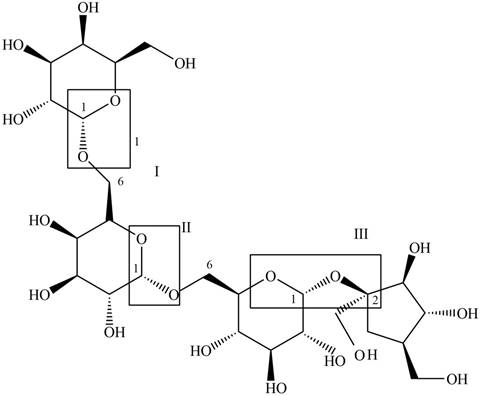
Figure 1
The acetals containing alkoxy groups attached to anomeric carbons in the stachyose represent the glycosidic linkages. The red colored oxygen atoms are a part of glycosic linkages.
The glycosidic linkages of the stachyose are shown in Figure 1.
(b)
Interpretation: Each glycosidic linkages of the stachyose are to be classified as
Concept introduction: Monosaccharides are the small units of simple sugars. Polysaccharides are made up of small units of monosaccharides. These small units are joined together by glycoside linkage.
Answer to Problem 28.66P
The glycosidic linkage
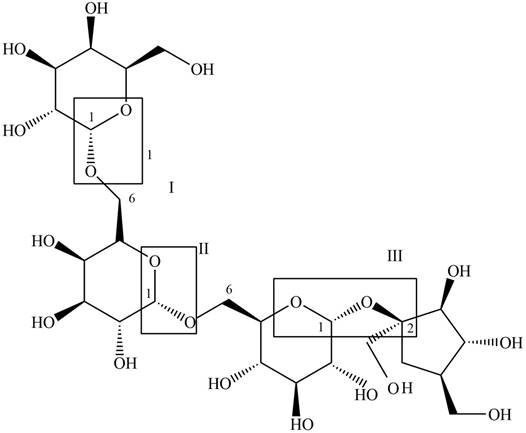
Figure 1
Explanation of Solution
The structure of stachyose,
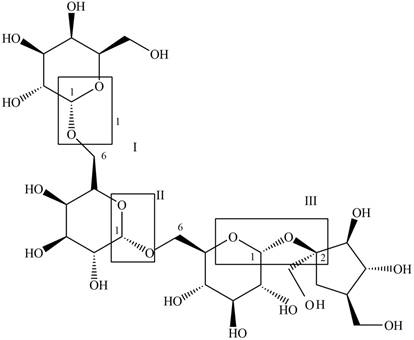
Figure 1
The glycosidic linkages which are composed of alkoxy group above the plane are
The glycosidic linkage
(c)
Interpretation: The products formed on hydrolysis of stachyose are to be predicted.
Concept introduction: Glycosidic linkages are hydrolyzed in presence of acid to form cyclic hemiacetal and corresponding alcohol. Acetals in the presence of acid undergo hydrolysis to form cyclic hemiacetals.
Answer to Problem 28.66P
The products formed on hydrolysis of stachyose are,

Figure 2
Explanation of Solution
On acidic hydrolysis of stachyose, the glycosidic linkages are cleaved to form the four products. The corresponding

Figure 3
The products formed are
(d)
Interpretation: The validation to the corresponding fact that whether stachyose is reducing sugar or not is to be stated.
Concept introduction: The reducing sugars contain hemiacetal and they undergo mutarotation. These sugars are in equilibrium with cyclic monosaccharide forms.
Answer to Problem 28.66P
Stachyose is not a reducing sugar.
Explanation of Solution
The given tetrasaccharide stachyose does not contain any hemiacetal and does not undergo mutarotation. Thus, the given tetrasaccharide is not a reducing sugar.
The product formed on treatment of stachyose with excess
(e)
Interpretation: The product formed on treatment of stachyose with excess
Concept introduction: The hydroxyl groups of monosaccharides are converted into the ether groups in presence of base and
Answer to Problem 28.66P
The product formed on treatment of stachyose with excess
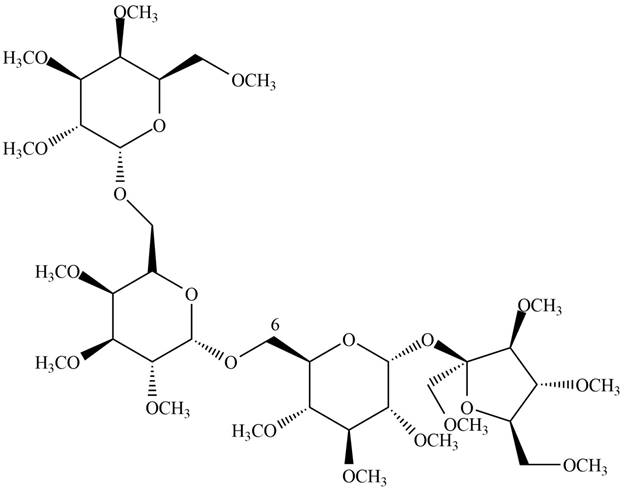
Figure 4
Explanation of Solution
On treatment of stachyose with excess
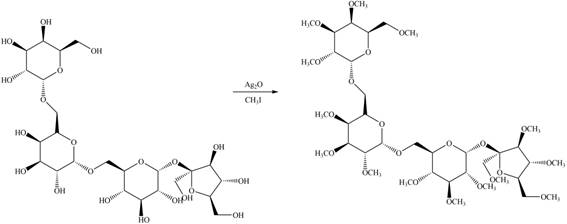
Figure 5
The product formed on treatment of stachyose with excess
(f)
Interpretation: The product formed on treatment of product in (e) with
Concept introduction: Glycosidic linkages are hydrolyzed in presence of acid to form cyclic hemiacetal and corresponding alcohol. Acetals in the presence of acid undergo hydrolysis to form cyclic hemiacetals.
Answer to Problem 28.66P
The products formed on treatment of product in (e) with
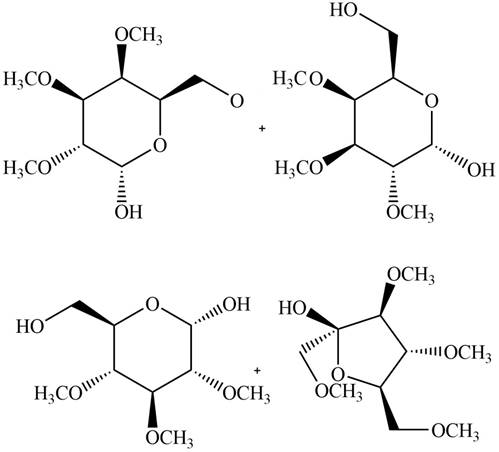
Figure 6
Explanation of Solution
On acidic hydrolysis of the given compound, the glycosidic linkages are cleaved to form the four products. The corresponding chemical reaction is shown below.
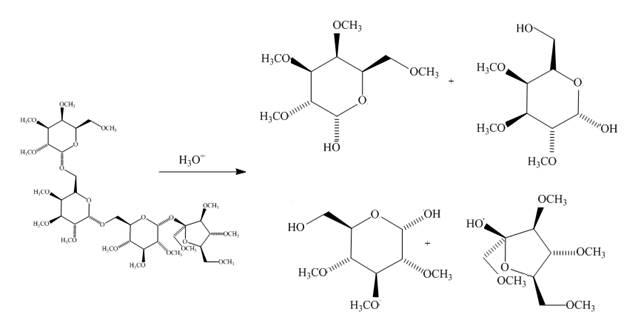
Figure 7
The products formed on treatment of product in (e) with
Want to see more full solutions like this?
Chapter 28 Solutions
Package: Loose Leaf for Organic Chemistry with Biological Topics with Connect Access Card
- Provide the correct IUPAC name for the compound shown here. Reset cis- 5- trans- ☑ 4-6- 2- 1- 3- di iso tert- tri cyclo sec- oct but hept prop hex pent yl yne ene anearrow_forwardQ6: Predict the major product(s) for the following reactions. Note the mechanism (SN1, SN2, E1 or E2) the reaction proceeds through. If no reaction takes place, indicate why. Pay attention to stereochemistry. NaCN DMF Br σ Ilm... Br H Br H H NaCN CH3OH KOtBu tBuOH NaBr H₂O LDA Et2O (CH3)2CHOH KCN DMSO NaOH H₂O, A LDA LDA Systemarrow_forwardQ7: For the following reactions, indicate the reaction conditions that would provide the indicated product in a high yield. Note the major reaction pathway that would take place (SN1, SN2, E1, or E2) Note: There may be other products that are not shown. There maybe more than one plausible pathway. Br H3C OH H3C CI ... H3C SCH2CH3 CI i SCH2CH3 ཨ་ Br System Settarrow_forward
- Q2: Rank the compounds in each of the following groups in order of decreasing rate of solvolysis in aqueous acetone. OSO2CF3 OSO2CH3 OH a. b. CI Brarrow_forwardох 4-tert-butyl oxy cyclohex-1-ene Incorrect, 1 attempt remaining The systematic name of this compound classifies the -OR group as a substituent of the hydrocarbon, which is considered the principal functional group. The ether substituent is named with the suffix 'oxy'. The general format for the systematic name of a hydrocarbon is: [prefix/substituent] + [parent] + [functional group suffix] Substituents are listed in alphabetical order. Molecules with a chiral center will indicate the absolute configuration at the beginning of its name with the R and S notation.arrow_forward5. Compressibility (6 points total). The isothermal compressibility is a measure of how hard/easy it is to compress an object (how squishy is it?) at constant temperature. It is др defined as Br=-()=-(200²)T' (a) You might wonder why there is a negative sign in this formula. What does it mean when this quantity is positive and what does it mean when this quantity is negative? (b) Derive the formula for the isothermal compressibility of an ideal gas (it is very simple!) (c) Explain under what conditions for the ideal gas the compressibility is higher or lower, and why that makes sense.arrow_forward
- 19. (3 pts) in Chapter 7 we will see a reaction of halocyclohexanes that requires that the halogen occupy an axial position with this in mind, would you expect cis-1-bromo-3-methylcyclohexane or trans-1-bromo-3-methylcyclohexane to be more reactive in this reaction? Briefly explain your choice using structures to support your answer. Mere-eries-cecleone) The tran-i-browse-3-methylcyclohexionearrow_forwardPlease help me calculate the undiluted samples ppm concentration. My calculations were 280.11 ppm. Please see if I did my math correctly using the following standard curve. Link: https://mnscu-my.sharepoint.com/:x:/g/personal/vi2163ss_go_minnstate_edu/EVSJL_W0qrxMkUjK2J3xMUEBHDu0UM1vPKQ-bc9HTcYXDQ?e=hVuPC4arrow_forwardProvide an IUPAC name for each of the compounds shown. (Specify (E)/(Z) stereochemistry, if relevant, for straight chain alkenes only. Pay attention to commas, dashes, etc.) H₁₂C C(CH3)3 C=C H3C CH3 CH3CH2CH CI CH3 Submit Answer Retry Entire Group 2 more group attempts remaining Previous Nextarrow_forward
- Arrange the following compounds / ions in increasing nucleophilicity (least to most nucleophilic) CH3NH2 CH3C=C: CH3COO 1 2 3 5 Multiple Choice 1 point 1, 2, 3 2, 1, 3 3, 1, 2 2, 3, 1 The other answers are not correct 0000arrow_forwardcurved arrows are used to illustrate the flow of electrons. using the provided starting and product structures, draw the cured electron-pushing arrows for thw following reaction or mechanistic steps. be sure to account for all bond-breaking and bond making stepsarrow_forwardUsing the graphs could you help me explain the answers. I assumed that both graphs are proportional to the inverse of time, I think. Could you please help me.arrow_forward
 Introductory Chemistry: An Active Learning Approa...ChemistryISBN:9781305079250Author:Mark S. Cracolice, Ed PetersPublisher:Cengage Learning
Introductory Chemistry: An Active Learning Approa...ChemistryISBN:9781305079250Author:Mark S. Cracolice, Ed PetersPublisher:Cengage Learning Introductory Chemistry: A FoundationChemistryISBN:9781337399425Author:Steven S. Zumdahl, Donald J. DeCostePublisher:Cengage Learning
Introductory Chemistry: A FoundationChemistryISBN:9781337399425Author:Steven S. Zumdahl, Donald J. DeCostePublisher:Cengage Learning Introduction to General, Organic and BiochemistryChemistryISBN:9781285869759Author:Frederick A. Bettelheim, William H. Brown, Mary K. Campbell, Shawn O. Farrell, Omar TorresPublisher:Cengage Learning
Introduction to General, Organic and BiochemistryChemistryISBN:9781285869759Author:Frederick A. Bettelheim, William H. Brown, Mary K. Campbell, Shawn O. Farrell, Omar TorresPublisher:Cengage Learning- Chemistry: Matter and ChangeChemistryISBN:9780078746376Author:Dinah Zike, Laurel Dingrando, Nicholas Hainen, Cheryl WistromPublisher:Glencoe/McGraw-Hill School Pub Co
 Chemistry for Today: General, Organic, and Bioche...ChemistryISBN:9781305960060Author:Spencer L. Seager, Michael R. Slabaugh, Maren S. HansenPublisher:Cengage Learning
Chemistry for Today: General, Organic, and Bioche...ChemistryISBN:9781305960060Author:Spencer L. Seager, Michael R. Slabaugh, Maren S. HansenPublisher:Cengage Learning ChemistryChemistryISBN:9781305957404Author:Steven S. Zumdahl, Susan A. Zumdahl, Donald J. DeCostePublisher:Cengage Learning
ChemistryChemistryISBN:9781305957404Author:Steven S. Zumdahl, Susan A. Zumdahl, Donald J. DeCostePublisher:Cengage Learning





